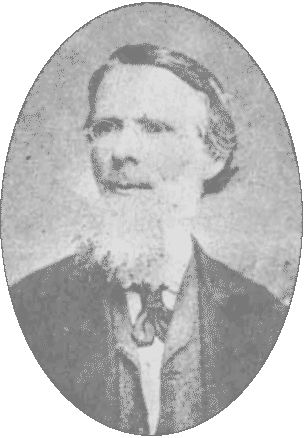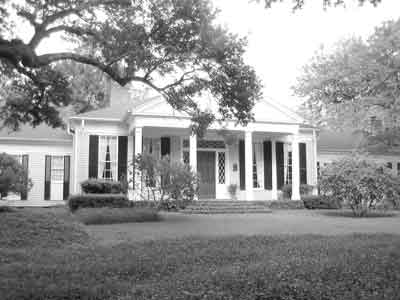"Raymond Years Ago"
By George W. Harper
Journalist - Editor - Owner Of Hinds County Gazette 1845-1883
A Series Published in the Hinds County Gazette, 1878-1879
From the Gillespie Collections edited by Pattie Adams Snowball and Rebecca Blackwell Drake
Home Page
Harper Arrives in Mississippi
Vicksburg & Meridian RR
Businesses in 1844
The Raymond Bar
Early Merchants
1844 Businesses
Seat of Justice
Cotton Industry
Early Churches
Establishment of Schools
John B. Peyton
Raymond Area Homes
Medicinal Resorts & Spas
The Mexican War
Early Churches
Early Schools
Raymond Female Institute
Raymond Military Institute
McNutt-Foote Debate
1844 Presidential Election
Local Elections of 1845
Literary Raymond
Raymond Fires
Old Log Jail
Death of Jos. Stewart
Murder of Benj. Sims
Duel Ends in Death
Raymond & Bolton RR
Harper Elected Mayor
Chaos at Oak Tree Hotel
Great Fire of 1858
Early Area Settlements
-
Amsterdam
-
Yeizer's Store
-
Newtown
-
Meridian Springs
-
Sturgiss Store
-
Dry Grove
-
County Line
Rev. Fisk's Biology Class
Fisk Charged with Fraud
Fleetwood Tragedy
Local Racetracks
Dignitaries Visit Raymond
Winning the Lottery
Fire Company No. 1
"Devoted & Valued Friend"
Tribute to Amos Johnson
Yellow Fever Strikes Raymond
Doctors Treating Victims
Cooper's Well
Mississippi Springs
Newspaper Entrepreneurs
Yankees Sack Gazette Office
Fate of Editorial Giants
Henry Clay Defeated in 1844
Stray Cats in Raymond
"A Remarkable Occurrence"
Blow That Punky Bell to Hell"
Isom Bldgs Destroyed
1851 Gubernatorial Election
Union Ticket Sweeps State
New Raymond Courthouse
Gibbs Building Rebuilt
Hinds Co. Poor House
Schools Struggle
Murder of Addie Owens
War comes to Raymond
The Battle of Raymond
Willie Foote Captured
Make-shift Hospitals
Yankees Occupy Raymond
Raymond Lodge No. 21
Odd-Fellows' Graveyard
Bolls Incarceration
Crimes Blamed on Whisky
Peyton's Willow Tree Prank
Politics in Raymond
Presidential Election 1860
Hinds Co. for Succession
Raymond Fencibles Organized
Churches Reorganize
The Clinton Riot of 1875
Why the Great Uneasiness?
Deaths of Sivley & Thomson
"Kill the Raymond Men"
Harrison Election
Political Gatherings
Event at Dupree's Grove
Presidential Election 1876
Governor Ames Impeached
Great Wrongs Investigated
Fight the Devil with Fire
Reconstruction Era
Harper Ends with Poetic Vision
George W. Harper
Owner and Editor of the Hinds
County Gazette 1845 - 1883
By Rebecca Blackwell Drake
 George
Harper was born in Alexandria, Virginia, in 1824, but moved to Wheeling,
two-hundred miles west, at a young age. While in Wheeling, he was attracted to
the newspaper business and at the age of thirteen he was hired by the
Wheeling Daily Gazette. By the time George reached eighteen, he and a
partner purchased the Daily Gazette and for the next two years he served
as editor.
George
Harper was born in Alexandria, Virginia, in 1824, but moved to Wheeling,
two-hundred miles west, at a young age. While in Wheeling, he was attracted to
the newspaper business and at the age of thirteen he was hired by the
Wheeling Daily Gazette. By the time George reached eighteen, he and a
partner purchased the Daily Gazette and for the next two years he served
as editor.
In 1844, at the age of twenty-one, George decided to leave Wheeling and move south to Raymond, Mississippi, where his uncle, Green North, owned and operated a newspaper publication known as the South-Western Farmer. George was hired to work with his uncle but the paper soon went under and he was forced to go in other directions. The direction he chose was to establish another newspaper called the Raymond Gazette which became quite popular with the people. He later changed the name to the Hinds County Gazette in order to command a larger reading audience. Harper soon became the sole owner and editor of the paper.
In 1852, eight years after arriving Raymond, Harper married Anna Sims, the daughter of Benjamin Sims, a plantation owner from Mississippi Springs. Together he and Anna had sixteen children. Harper was a family man, a religious man and an American patriot who was extremely devoted to his country. When Harper arrived in Raymond, he believed in the United States of America and stood behind the Union in every way. During the 1850s, when the tragic breakdown between the North and the South began to occur, he staunchly stood up for the Union over secession. His devotion to the Union was short-lived, however, when on January 9, 1861, the announcement came that Mississippi had seceded from the Union. Harper was forced to choose and the decision he made was to stand with his fellow Southerners. During and after the war, he published editorials in the Gazette to help guide the people of Hinds County through military defeat as well as economic ruin. Not once did he say to his reading audience, “I told you so.”
After the war, the Harper family bought the antebellum house in town now known as Phoenix Hall. At the time, Phoenix Hall was located almost directly in front of Alston Springs, a public gathering place famous for its political rallies. Alston Springs disappeared with the passing of time but Phoenix Hall can still be seen on Palestine Street in Raymond today.

Phoenix Hall, located on Palestine Street, was the home of the Harper family in the years following the War. |
Over time, Harper became one of the most respected newspaper editors in the state. He was also a respected citizen having been elected mayor of Raymond and, on two occasions, elected to the state House of Representatives from Hinds County on the Union Party ticket.
In 1878, after serving as owner/editor of the Hinds County Gazette for 34 years, Harper decided to feature a twenty-three-week series for the paper recalling the town’s history. The series was titled Raymond Years Ago. The first article in the series, dated November 14, 1878, begins with a poetic description of the snow-clad mountains of Virginia the day Harper left home: “The rugged and precipitous mountains of Western Virginia were covered with a beautiful mantle of snow on the morning of the 15th of October, and the air was pure and frosty. The sun rose clear, bright and beautiful and as its first rays kissed the mountain’s side, the sparkling was not unlike that which would have been reflected by the most precious diamonds.”
Each of the twenty-three articles relates various aspects of Raymond’s history and events which occurred between 1844 and 1879. Early in the series he describes the town - the churches, schools and businesses, and introduces many of the pioneer citizens. Later in the series he takes the readers through the Battle of Raymond, the Clinton Riot, and the dark days of Reconstruction.
While describing the town in a political light, Harper recalls meeting some of the state’s finest political figures who frequented the old Raymond Courthouse: Sergeant Prentiss, orator and statesman; Andrew Jackson, former president of the United States; Alexander McNutt, John I. Guion, and Henry Foote, former governors; and Jefferson Davis who later became president of the Confederacy.
In 1879, in articles twenty-one, twenty-two and twenty three, Harper focuses on Raymond and the Reconstruction era, a threatening and depressing period throughout the South which began in 1865 and ended in 1877. The articles bring to light the difficult times for post-war Mississippians whose governor, Aldebert Ames, a former Union general, allowed carpetbaggers and scoundrels to rule the day. Ames was ultimately impeached for crimes against the state. Around this time, the Democratic Party urged Harper to run for governor of Mississippi but he rejected the offer saying that he was “worn out.”
Harper had every reason to be “worn out.” In addition to his work at the Gazette, he also had sixteen children to nurture. The youngest was a girl named Mamie who was born in 1878 - the same year he began the series Raymond Years Ago. Harper was fifty-four years old when Mamie was born. In later years, Mamie became the grandmother of the great Mississippi writer, Willie Morris, from Yazoo City. Willie recalled the day he left for the University of Texas that Grandmother Mamie kissed him good bye and reminded him, “There’s ink in your blood.” She was right. After college and a continued education in Oxford, England, Willie moved to New York City where he became the youngest editor-in-chief of Harper’s Magazine, founded in New York City in 1850.
Harper published the final article on April 17, 1879. Just as he began the series on a poetic note, he also ended on a poetic note: “Morning, noon and night come and go. And so, too, evening’s shades and midnight’s gloomy hour. And the beautiful foliage with which all Nature is now clothed, will ere long pass away, giving place to the sere [withered] and yellow leaf. Every man, the proudest and noblest of God’s creatures has his day. He comes, he goes, almost as the passing breeze - and soon he and his deeds, whether good or evil, are forgotten. And these Notes on the past career of a village dear to our heart, must like everything earthly, have an end.”
In closing, Harper predicted the impact that his articles would have in future generations: “Twenty-three weeks have passed since the Notes on Raymond Years Ago were commenced, and every week a number has appeared in these columns. If collected and published in books form, they would make a pamphlet of one-hundred or more pages; and would cover perhaps the entire space of two or three issues of the Gazette…. we can say that fifty years from now they will be read with more interest than they have been while passing through the press.”
|
This prophetic statement has certainly proven to be true. Never in a million years would George Harper have ever been able to fathom the concept of the Computer Age and the fact that his articles, edited and placed on the Internet, would be read by an audience of thousands. Harper continued to serve as owner and editor of the Hinds County Gazette until 1883 when he retired (age 59) and turned the paper over to his son, Samuel Dawson Harper. Harper continued to live in Raymond until his death in 1894.
All photographs and illustrations were edited into the series by Pattie Snowball and Rebecca Drake.
Copyright © 2008 PattieAdams Snowball, James and Rebecca Drake
